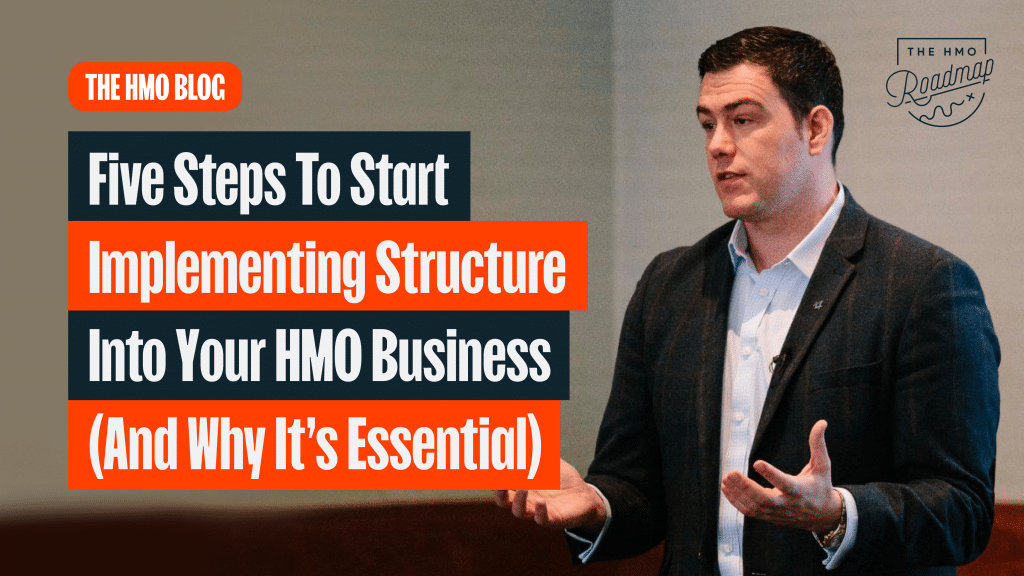
Structure is a pillar you need to build into your HMO business as quickly as possible. Without structure, the systems you implement into your business won’t work, you’ll have a higher staff and tenant turnover and ultimately, you’ll make less money from your HMO properties.
Here we’ll cover the importance of having structure into your HMO property business and how to implement this. If you’re feeling overwhelmed, don’t panic. We provide easy solutions to help you start building structure into your business now!
Read about these steps below or listen to the full episode on The HMO Podcast with me and my good friend, advisor and mentor John Paul.
Importance of Structure
Structure is crucial to any business but especially a HMO business. Without structure, you can’t be profitable, efficient or productive. And you’ll just be left with chaos!
Having systems and processes written down in detail allows you to create structure within your business, provide accountability and ensure standards are being maintained.
Take the time to look at every part of your business and try to implement structure into it. With hundreds of different laws in the HMO industry, legislation and legal obligations are very important areas of your business you can apply this to.
When I bought my first HMO over a decade ago, it was complete chaos. I didn’t have any structure in place! Several years on, we grew quickly and came to a point where we had to implement structure within the business.
If we didn’t, we were going to burn through lots of cash. And now, we talk about structure on a weekly, monthly and quarterly basis to keep pushing the business forward.
When Should Structure be Implemented?
Structure is extremely relevant in the early stages of building a HMO portfolio. The best time to start implementing structure is right at the beginning, even before you have a HMO on the books.
It’s easier to implement structure at this point as you can set good habits right from the start. If you wait until you have a bigger business, you’ll likely feel like you don’t have the time to set aside for this. And before you know it, a regulatory or compliance issue may come up.
You may be asking yourself how do I even begin developing my business structure? Well, fear not because we’ve set out an easy step-by-step plan to help you start implementing structure into your HMO business today!
How to Start Implementing Structure
No matter where you are with your HMO business, you need to follow the same steps to implement structure. Here are the 5 steps to start developing this within your business.
1.List the Problems
For starters, write down a list of the problems you’re currently experiencing. Look at the reoccurring problems. Are there any trends? Are the same mistakes being repeated? Start thinking about what you could put in place to make sure these don’t happen again.
2. Analyse the Issues
Compartmentalise the different issues. Break them down and put them into manageable boxes. Without a strategic plan, how can you fix the problems your business faces? Come up with a mini-plan of how to tackle the problems.
3. Prioritise Tasks
Now, figure out what the most serious issues are. Decide what you need to manage, identify and correct first, so you don’t end up in hot water. Make tackling the big problems and activities a priority.
4. Create Procedures
Write down your Standard Operating Procedures (SOPs), which are instructions on how your business operates and carries out certain activities. This could be about how you carry out a viewing, inspection or inventory or even what your strict parameters are for buying a HMO. You can then use these SOPs to train your staff members on the rules, regulations and processes.
5. Audit Your Business
Audit your procedures and staff to check that those accountability tasks are being met to the right standard. This will ensure you’re getting the performance you need out of the business, yourself and your staff.
When you audit your business, you’re ensuring your staff understand the rules and are following what they’ve been trained to do. After undertaking an audit, you should then provide feedback on the results and review the procedures, and make changes and improvements where necessary.
Structure is imperative, whether you have a small or large HMO business. Keep in mind that having structure in your business is not just about understanding how your business operates though, it’s also about checking and testing that it operates how you want it to.
For more useful resources and in-depth lessons to help you start, scale and systemise your HMO business, join The HMO Roadmap today!

About the Author:
Andy Graham is the founder and the lead trainer at The HMO Roadmap! He is also the co-founder of The HMO Mastermind and Smart Property, a specialist HMO property investment and management company. He writes as a regular columnist in different magazines about a variety of HMO topics and is the host of The HMO Podcast! Follow Andy on Instagram!